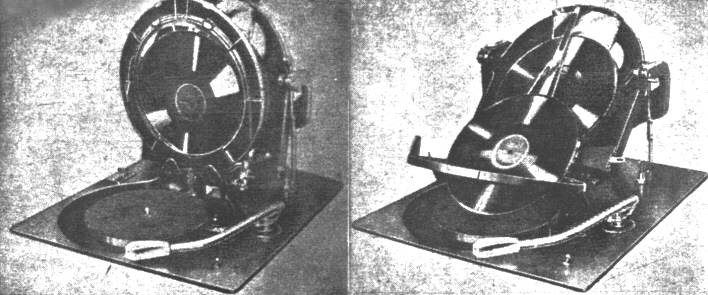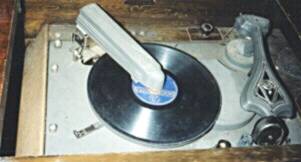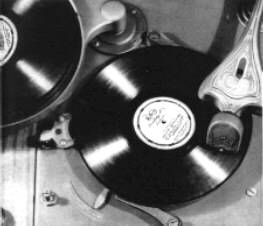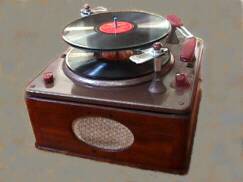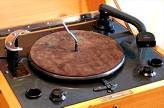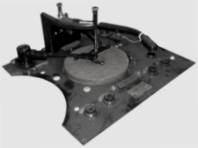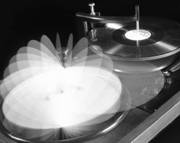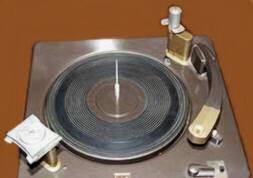- The first home record changer was the 1913 Autophone (US), a changer that held 12 cylinders, each on its own mandrill, in a Ferris-wheel arrangement. Powered by an electric motor, it continuously played the cylinders in sequence until turned off. It was a variant of a coin-op Autophone "jukebox" (the term had not yet been coined). This unit allowed a customer to turn the Ferris wheel with a knob, crank up the machine, and then play the one record he chose for a penny. 8-record and 12-record Ferris wheel disc jukeboxes was also made by Autophone, but these were never sold in a modified form for use as a home record changer, because the records were held to the turntables by wing nuts.
- The first demonstrated automatic record changer for discs was the Salonola, built in Australia in 1927. But the company went out of business before the machine was put into production. It was a push-type changer with a stepped center spindle and a pusher platform at the rim of the record. The platform was turned to set it for 10" or 12" records. The patent this company held was listed as being good 1920 to 1939, which might explain why the push-type changer was not available until 1936.
- The first disc record changer that was actually produced, the Automatic
Change Gramophone, was made in 1927 by the English company His Master's Voice
(HMV). This machine was the assembly-line-type, meaning that each record on
this type of changer went through a series of moves, as though it were on an
assembly line. Records were placed in a stack on a shelf at the left side of
the Automatic Change Gramophone. A vacuum arm picked up the top record from the
stack and placed it on the first turntable. A moving ring centered the record
on the turntable, and the acoustic tone arm played the top side. After the side
finished, the ring flipped the record over onto a second turntable, and the
same arm played the second side. When that ended, a second ring flipped the
record into a bin, and the entire process repeated for the next record. A
control set the changer for record size, so it could play 10" (25 cm) or
12" (30 cm) records, but not intermixed. The records for this were in the
manual sequence. A photo of the second model, a one-side version, appears
at right.
Record albums were made in different sequences by different companies, to be played on the different changers each company made. Often when a company introduced a different record changer design, it also changed the sequence of the records in the albums they pressed, so the new albums played correctly on the new changer. The three sequences used were:
- The Manual Sequence, for play on manual players and two-side changers.
- The Drop-Automatic Sequence, for changers that do not reverse the stack.
- The Slide-Automatic Sequence, for changers that reverse the stack.
Look at RECORD SEQUENCES for more about this.
- The Automatic Orthophonic, the first US disc record changer, was sold by the Victor Talking Machine Company (US), also in 1927, but slightly later than the Automatic Change Gramophone. It was a combination of the assembly line and drop-throwoff designs. The unplayed stack was held vertically by the center holes of the records, on a hook on the end of a support at the left side of the turntable. During the change cycle, the changing ring raised, and lifted the record on the turntable, depositing it into a drawer in the cabinet. Then the ring rose to the unplayed stack, lifted the next record off of the hook, and lowered it to the turntable. This changer also had to be adjusted for size. It could be bought with either an acoustic horn or an electrical pickup (used in conjunction with an RCA radio), and it used the drop-automatic sequence.
- The 1928 Brunswick Automatic Panatrope had a tall record magazine over the turntable, with 20 sets of movable shelves (one for each record) holding records by their edges. My great grandfather had one of these. During the change cycle, the centering ring flipped the record on the turntable into a bin. Then a second set of shelves appeared between each record and the one above it, and the shelves holding the records retracted. This dropped each record onto the new shelf just below it, with the bottom record sliding down a chute and onto the turntable. Then the shelves moved back to their initial positions and the records again dropped down, so each record ended up one position below where it was before the change cycle. The centering ring lowered the dropped record onto the turntable, and the arm played it. This unit could play only 10" records, but Brunswick later provided instructions on how to use a hacksaw to modify the changer for manual play of 12" records in addition to automatic play of 10" records. It also had to be periodically wound up again while it played - it had three cranks! It used the drop-automatic sequence, and played the records acoustically.
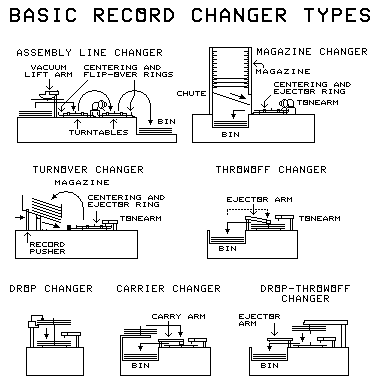
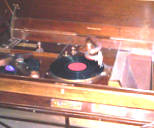
HMV Automatic Change Gramophone
(second model - one side version)
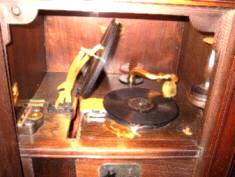
Victor Automatic Orthophonic
Photo courtesy of George Epple
- In 1928, the Capehart Company (US) made their Turnover record
changer. It had a basket, or magazine, where records were stacked on top of
each other. The centering ring flipped the record off of the turntable like
before. But on this changer, it placed it on the top of the stack after
turning it over. Then a pusher pushed the bottom record out of the basket
and onto the turntable, where the centering ring guided it into place. A
feeler arm sensed whether the record was 10" or 12", and the tone
arm played it. Since the record was turned over as it was placed on the stack
after it played, when it came to the turntable again, the other side was
up, so the changer could play every side in the stack.
This was the first record changer that could take intermixed record sizes in the same stack. It was also the first record changer with a velocity trip (see page 2 for a discussion on how record changer tripping methods work). It was first used for jukeboxes and store background music, and released for home units in 1931 after manual operation was added.
Since many classical records came in a manual sequence where both sides of each record were played before the next record was used, an alternating guide (not shown in the drawing) was provided to play this kind of record album. The guide could be activated so that both sides of the record would be played before the record stayed on the stack. It alternately took a record from the top of the stack, and then the bottom of the stack. When it took the record from the top of the stack, it played the other side of the record the ring had just put there. So the Capehart worked with either the manual sequence or the slide-automatic sequence.
An interesting feature of the Capehart was that it never ran out of records, since the played records were placed back in the stack. Later models had an automatic shutoff device with a dial that could be set for the chosen number of sides to be played, or for continuous play. This changer was made from 1929 to 1951, with an interruption for World War II.
- Victor also came up with its Improved Automatic Orthophonic changer that year. This held the records to be played on a shelf, used a combination of knife blades and a pushing action to separate the bottom record from the shelf, and a ring to lower the record to the turntable and to later eject it into a drawer after play. This changer could also intermix 10" and 12" records, and used the drop-automatic sequence.
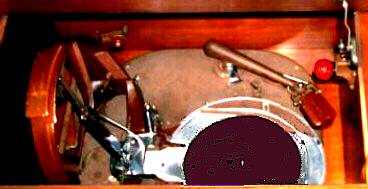
Capehart turner-changer
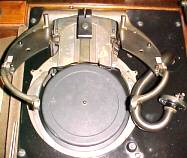
Improved Automatic Orthophonic
